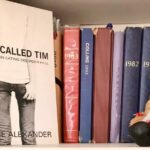Yes, I have a dream: the sock as a universal symbol of hope in stomping out ED
Yes, I have a dream: the sock as a universal symbol of hope in stomping out ED
This story begins in 1962 when I developed Anorexia Nervosa. Back then there was no Eating Disorder Awareness Week, or anything at all, to help my family understand the illness that had developed in my mind. For more than 40 years, the bully eating disorder kept me prisoner, destroyed relationships, almost took my life. Luckily along the way I met several people who believed in me, the real ‘June’ beyond the illness, and guided me to recovery.
Since 2007, in my mid-fifties , I have been free to live a full life, as June. I count my blessings, give thanks for this, every day. When one has spent decades ‘locked up’ in an illness in the mind, memories of the experience remain, the pain of loss can be acute. Which is why I do what I do – writing books, creating ‘awareness’ about eating disorders, helping to educate families, doctors and above all, sufferers, about their illness. Simply, like many advocates, I don’t want others to suffer like I did. I want them to get help fast, the right help, so they can recover and be free to enjoy their true life.
What is Eating Disorder Awareness?
This past week important issues have been raised and questions asked ‘what is eating disorder awareness?’ Obviously, the definition is different for different people, different organisations. The definition seems in danger of getting a little murky. We have eating disorders, obesity, body image, prevention, early intervention, anxiety, depression, inpatient treatment, outpatient treatment, no treatment at all. We have non-profit organisations devoted to the cause, we have vested interests, we have worn-out, desperate families, and we have tormented thousands living part-lives and we have mentally-bullied, suicidal sufferers. Somehow, we have to find ways to cut to the chase and keep the focus on the sufferers. They are what matter most to me. They have to try and live with this illness 24/7. They need understanding and guidance. The right sort.
Childhood Anxiety
I had not given a thought or even heard about body image or calories or wondered if I was overweight when I developed Anorexia. At the age of 10 and 11, however, I was feeling very anxious. I was sensitive and anxious. And in this vulnerable situation, Anorexia budded and came to stay. As a coping skill, it helped me survive by suppressing the anxiety, but at the same time, kept me a prisoner in my mind. A dangerous illness indeed.
A wise therapist, Belinda, suggested in my 40s, that by ‘focusing on feelings, the food will take care of itself’ and she was right. Easy to say, difficult to do, but after eight years of guidance in mindfulness and self-awareness, I accomplished the joy of being in touch with my true feelings and thoughts. I regained me. The Anorexia was bully no more. I was able to accomplish the joy of eating three meals and three snacks a day – without guilt or shame, without anxiety or fear. This was bliss.
Developing a Sense of Self
So a lot of my recovery had nothing to do with a lot of what we hear about in ED Awareness Week. My recovery involved getting in touch with my true self. It involved meeting one or two therapists and doctors who believed in me beyond the illness. It involved meeting people, like Belinda, who had the skill to establish trust with the real me, and give me the courage to trust their guidance sufficiently to let go of the extremely powerful and entrenched eating disorder. It involved developing a sense of self from within. It involved forever holding on to hope.
My wish for Awareness Week is that consensus be achieved on basic, evidence-based aims in helping people who develop an eating disorder, or are at risk of developing an eating disorder. About being aware of the symptoms of eating disorders, of the importance of early intervention, and if you missed the opportunity for treatment when you were young, of seeking helping today – for at every age there is hope.
Academy of Eating Disorders Conference
Later this month I will attend the 2014 AED ICED in New York – I previously attended this conference in 2010 in Salzburg, Austria. My overriding memory of the Salzburg Conference is shared below. Since 2010, I have met Erin’s inspiring mom, Joan Riederer, at eating disorder conferences in the US, and I look forward to meeting her, and others mentioned in this article, in New York. Joan’s family has established the Erin Riederer Foundation, in memory of Erin, and Joan works to raise awareness, educate and save the lives of others: Sockit3 2014International Project
In memory of Erin, I hope you will wear bright socks this week (and every week) as symbol of hope and in doing so, help stomp out ED. Four years after writing this article below, my dream remains to see a universal symbol, in the shape of a sock, for eating disorder awareness – similar to the Pink Ribbon for Breast Cancer. Yes, I have a dream.
ERIN’S SOCK OF HOPE
While delegates to the 2010 International Conference on Eating Disorders in Salzburg were engrossed in discussing the conference theme of “Moving Forward Through Transdisciplinary Solutions”, news came of a young woman’s death from the effects of Anorexia Nervosa.
The death of this young woman, Erin Riederer, has given rise to a symbol of hope in the fight against eating disorders
By June Alexander
Sometimes the darkest moment can be a catalyst for light. So it was at the 2010 international conference of the Academy of Eating Disorders in Salzburg, Austria. The sun was shining, it was about 30 degrees, and Laura Collins, Kitty Westin, Carrie Arnold and myself were eating lunch at a small round table under an umbrella outside a sidewalk café. Laura, Kitty and Carrie were from the USA, and I was from Australia. Our shared passion for raising awareness of eating disorders had brought us to this point. Laura and Kitty are mothers who, having experienced the challenge of seeking the right treatment for a child who develops an eating disorder, became activists and lobbyists, and Carrie and I are two writers who, having suffered from eating disorders, are devoted to raising awareness about these illnesses.
Kitty was to present at the international conference on eating disorders that very afternoon. And she was very upset. Not about the inspiring conference, which had attracted 600 researchers, clinicians and people like us from around the world, but about the news she had received from the USA only a short time before. Erin, aged 26, had died. Her death added to the statistics that show Anorexia Nervosa has the highest death rate of any psychiatric illness.
Laura also was visibly upset and angry; angry that Erin’s life had come to this. Any death is one too many. I’m sure Carrie was thinking as I was, ‘that could have been me’ and how fortunate we were to meet the right people at the right time to believe in us and offer us a lifeline. I don’t believe any of us would remember what we ate for lunch that day. We were as one in feeling for Erin’s long struggle, and that of her parents in seeking the right treatment. We were thinking of Erin’s lost life, and the sadness that forever more would be with her family. Kitty was striving to regain her composure, for she was to appear on the main stage within 30 minutes, and Laura also was to present a workshop later that same afternoon.
We were short on tissues and I rummaged around in my deep leather shoulder bag, seeking one to pass to Kitty to help stem her tears. Instead of pulling out a tissue, however, I pulled out a sock; a sock belonging to my daughter Amanda. I felt embarrassed as, although laundered, the sock was far from sparkling white (it had got mixed up with my grandchildren’s clothes after a visit, and I had intended to give it to Amanda before boarding the plane at Melbourne for Salzburg).
The sock, buried in the lower reaches of my bag, had dodged my memory and the airport security cameras, and hitched a free ride to Salzburg.
This was a sock with a purpose.
Tentatively I offered it to Kitty, and she took it gratefully. It was one of those anklet sport socks with towelling inside, so was quite soft and ‘squeeze-able’. Kitty dabbed her eyes and clutched the sock. Somehow it was giving her comfort. When the time came for us to head back to the conference centre, where Kitty would bravely walk on to the stage, she asked if she could take the sock with her.
‘Of course,’ I said. Kitty made a great speech. Her courage was immense.
After the conference, I headed home to Australia and Kitty, Laura and Carrie headed home to the US. Susan Ringwood, who was heading home to the UK where she is head of BEAT, the UK’s largest non-profit eating disorder charity, also was very much part of our support circle. The sock hitched another free ride, this time to the USA with Kitty.
When I told my daughter Amanda about her well-travelled sock and its role at the eating disorder conference in Salzburg, and of its new home in the US, she was delighted that although not there herself, her sock had helped lighten and overcome a deeply emotional and sad moment.
Kitty then wrote to say the Crying Sock, as she termed it during this poignant time, (Kitty’s daughter Anna died in 2000 after struggling with Anorexia for five years), was accompanying her to the celebration of Erin’s life. The sock, in its comforting role, was attending Erin’s funeral.
The sock was fast becoming a symbol of all that we hope to achieve in raising awareness of and treating eating disorders. It is an item that every member of the family wears (a reminder that eating disorders affect every member of the family), and that in its various forms appeals to all ages; it is an item that is comforting; that can be worn for warmth; that can be cuddled and squeezed, can dry tears and absorb the release of intense emotion; that can be washed, carried anywhere and everywhere; that can offer hope when confined to bed and can spread the word when walking down the street, playing sport or marching on government.
Erin’s lost life has given birth to the ‘sock’ symbol. Erin’s mother Joan and family have given their permission for creation of a symbol to be known as Erin’s Sock of Hope. A small international committee of ‘socksters’ has been formed to establish Erin’s Sock of Hope as a global symbol of eating disorders. Erin’s spirit, and that of all who have lost their lives to eating disorders, will live on through the sock and give hope to others.
The eating disorder field will benefit in numerous ways from the creation of an easily recognisable and identifiable symbol to unite efforts in raising awareness around the world, and the serendipity that produced the Crying Sock, now Erin’s Sock of Hope, is a sure sign that the sock is meant to be.
Postscript:
Every day, more threads of shared enthusiasm and passion add to the strong foundation for Erin’s Sock of Hope.
Two ‘sock’ threads are evolving – the sock to be worn on the feet and the sock symbol to be worn as a pin or brooch. The vision is for hand-made socks and commercially produced socks.
The hand-made socks and pin/brooch will be a soothing gift for families when an eating disorder is diagnosed — the sense of purpose in creating and giving a sock and the comfort in receiving a sock will be therapeutic for all participants. The sock symbol pins (brooches) will complement the actual sock for families battling eating disorders, and add to the sense of belonging and acknowledgement.
Besides bringing comfort to families directly affected by eating disorders, sales of pins/brooches and commercially produced socks emblazoned with Erin’s Sock of Hope symbol in the wider community will raise awareness and funds for research and treatment-assistance. Let’s Sock it to Ed!
* Congratulations to Susan Ringwood, and Beat, UK: http://www.b-eat.co.uk/support-us/get-involved/eating-disorders-awareness-week/the-inspiration-for-sock-it/





